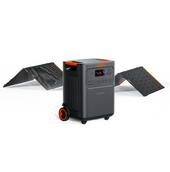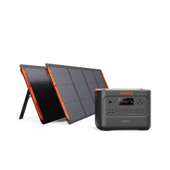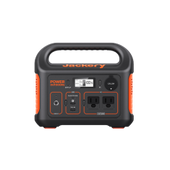Amps and ohms are essential units that measure electricity. While amps measure the electron flow in a circuit, ohms indicate the resistance to that flow. The amps-to-ohms conversion helps us understand how electricity works. It's also essential to design and build safe and efficient electrical circuits.
Jackery Portable Power Stations have high watts and amps value, making them ideal for home backup solutions and outdoor adventures. With the portable power station, you can use free solar energy to charge most of your home or outdoor appliances. This guide reveals how to convert amps to ohms and choose portable power stations that are ideal for power appliances.
What Are Amps to Ohms?
Amps generally measure the amount of electricity that flows through the circuit. In other words, it's the number of electrons moving through the wire. The larger the amp value, the more electricity can flow through the electric circuit. Most household outlets are powered by 15-amp or 20-amp circuits. If you're trying to run multiple appliances on the same circuits, the power may trip or cut off to prevent overheating.
Electric circuits are made of wires, and they are not perfect conductors. These wires are made of aluminum or copper and have some amount of friction or resistance. Ohm is the standard unit of electric resistance that slows down the flow of electricity in the circuits. In other words, one ohm is the resistance when a constant potential difference of 1 voltage produces a current of 1 amps.
The resistance R in ohms (Ω) is equivalent to the voltage V in volts (V), divided by the current I in amps (A). Here's the mathematical representation:
Ohms = Volts ÷ Amps or Ω = V ÷ I
How to Convert Amps to Ohms? How to Convert Ohms to Amps?
There are multiple use cases when you might need to convert amps to ohms and vice versa. Here are the formulas to execute the conversions.
Convert Amps to Ohms
Here's how to convert amps to ohms if you know watts or volts.
Formula 1:
In order to convert ohms to amps, you'll need to know the voltage (V). The resistance in ohms is equal to volts divided by amps:
R (Ω) = V (V) ÷ I (A) or Ω = V ÷ A
Example 1:
If the voltage supply is 12 volts and the current flow in the electrical circuit is 0.6 amps, the resistance in the circuit can be calculated using the below formula:
R (Ω) = V (V) ÷ I (A) = 12 V ÷ 0.6 A = 20 Ω.
Formula 2:
If you know the wattage (or power in watts), consider dividing the power in watts by the square value of current in amps to get resistance.
R (Ω) = P (W) ÷ I2 (A) or Ω = W ÷ A2
Example 2:
Let's calculate the resistance of the electrical circuit with a current flow of 0.5 amps and a power consumption of 30 watts.
R (Ω) = P (W) ÷ I2 (A) = 30 W ÷ (0.5)2 = 120 Ω.

Convert Ohms to Amps
Here’s how to find amps with volts and ohms:
Formula 1:
You need volts or watts to calculate amps to ohms because ohms and amps represent different quantities. The current I in amps is equal to voltage in volts divided by resistance in ohms.
I (A) = V (V) ÷ R (Ω) or A = V ÷ Ω
Example 1:
If the electrical circuit with a voltage supply of 12 V has a resistance of 60 ohms, the current can be easily calculated using the formula:
I (A) = V (V) ÷ R (Ω) = 12 V ÷ 60 Ω = 0.2 A.
Formula 2:
If you know the voltage in volts, you can also calculate the current (I) from ohms. The current is equal to the square root of power in wattage divided by the resistance in ohms.

Example 2:
If the power consumption is 30 watts and the electrical resistance is 120 ohms, the current of the electrical circuit can be calculated as:


Now that you know the different formulas to convert ohms to amps and vice versa, here's a table that reveals common conversions.
|
Watts |
Amps |
Ohms |
|
50 W |
0.21 A |
1152 |
|
100 W |
0.42 A |
576 |
|
150 W |
0.63 A |
384 |
|
200 W |
0.83 A |
288 |
|
250 W |
1.04 A |
230.40 |
|
300 W |
1.25 A |
192 |
|
350 W |
1.46 A |
164.57 |
|
400 W |
1.67 A |
144 |
|
450 W |
1.88 A |
128 |
|
500 W |
2.08 A |
115.20 |
|
550 W |
2.29 A |
104.73 |
|
600 W |
2.50 A |
96 |
|
650 W |
2.71 A |
88.62 |
|
700 W |
2.92 A |
82.29 |
|
750 W |
3.13 A |
76.80 |
What Is Ohm's Law?
According to Ohm's Law, the current flowing through the conductor between two endpoints is directly proportional to the voltage in volts. It's true for circuits with only resistive elements, regardless of whether the driving current or voltage is time-varying (AC) or constant (DC).
Here's the mathematical representation of Ohm's Law:
V = I × R
R = V ÷ I
I = V ÷ R
Where,
V is the voltage in volts
I is the current in amps
R is the resistance in ohms
Understanding the relationship between voltage, resistance, and current is essential for performing electrical calculations. To apply Ohm's Law in the electrical circuit, you must determine what variables you know from voltage, current, and resistance. Next, you can choose the appropriate formula and substitute the values into it.
Let's take an example to understand:
The voltage required for a circuit with 10 ohms of resistance that needs 5 amps of current to function will be:
Voltage = Amps × Resistance = 5 A × 10 Ω = 50 V.
One important thing to remember is that Ohm's Law is typically applicable to resistive circuits. This means you may need to apply additional formulas for circuits with capacitors and inductors.
Here's the Ohm's Law formula wheel that represents the relationship between P, I, V, and R. If you want to use the Ohm's Law wheel, all you need to do is choose the variable that needs to be calculated in the middle of the wheel and then use the relationship for the other two known variables within the cross-section of the circle.

Jackery Portable Power Stations Explained
Jackery is a reputable brand that manufactures high-quality and highly efficient solar generators, portable power stations, and solar panels. The Jackery Portable Power Stations are battery-powered inverter generators featuring multiple AC outlets, USB charging ports, and a DC carport. These portable power stations can be recharged with Jackery SolarSaga Solar Panels, a car charger, and a wall outlet.
When the direct sun's rays fall on the Jackery SolarSaga Solar Panels made with monocrystalline silicon solar cells, the solar energy is converted to DC electricity. The pure sine wave inverter in the stable Jackery Portable Power Station converts the DC to AC electricity, which can then charge most household or outdoor appliances like refrigerators, lights, microwaves, electric grills, etc.
The Jackery Portable Power Stations have large battery capacity (watts), volts, amps, and ohms value. The larger battery capacity will help you charge most small and large household appliances for long hours. Here are the popular Jackery Portable Power Stations for different use cases:
Jackery Explorer 3000 Pro Portable Power Station
The large and powerful Jackery Explorer 3000 Pro Portable Power Station features a large NMC battery with a 3024 Wh capacity and 3000 W output power. It has a high amp-hour rating of 70 Ah with a voltage of 43.2 V DC. The portable power station can charge 99% of household appliances, including a large refrigerator (300 W) for 8.5 hours, an AC (1000 W) for 2.5 hours, and even a TV (150 W) for 17.1 hours. It has a battery life of 2000 cycles, after which the capacity reduces to 70%.

Customer Review
"I've tried out my washing machine, gas dryer, my electric lawn mower and charged my phone. I've even charged the generator while powering devices with it. My idea of what solar and batteries can do has been greatly expanded. This unit delivers real power." — P.V.
Jackery Explorer 1000 Plus Portable Power Station
The Jackery Explorer 1000 Plus Portable Power Station features a stable LiFePO4 battery that can be expanded from 1.2 kWh to 5 kWh with the help of the additional Jackery Battery Pack 1000 Plus. It has a high amp-hour rating of 30.4 Ah, which works at 41.6 V DC. With the help of high watt-hour and amp-hour ratings, the portable power station is capable of charging 99% of household appliances. The power station has a battery life of 4000 cycles, after which the battery works at 70% capacity.

Customer Review
"If you enjoy the outdoors but can't live without your gadgets, then you need something like this. I took this unit out last weekend, and it performed as expected. It charged my Segway scooter, MacBook, and a couple of small gadgets. The Jackery app enables you to control several functions of this power station." — Chris.
Jackery Explorer 300 Plus Portable Power Station
The Jackery Explorer 300 Plus Portable Power Station also features a stable and safe LiFePO4 battery with 288 Wh capacity. It has a high amp-hour rating of 22.5 Ah and 12.8 V DC, which makes the portable power station ideal for home or outdoor appliances. The durable battery, with a 10-year lifespan, provides a constant voltage and ensures safety while charging appliances. It also has innovative ChargeShield technology to offer protection against potential equipment damage.

Customer Review
"Lightweight, making it portable, can charge a phone, laptop, plug in lights, & a small appliance for cooking. High-quality equipment for home after storms, bug-out evac, or camping. Thank you for enabling greater peace of mind." — Marie.
How to Calculate Resistance in DC & AC Circuits?
Ohm's Law is an essential relationship between voltage, current, and resistance. Here's a brief definition of these electrical terms:
Resistance: It's the rate at which any material resists the flow of current. It is measured in ohms.
Voltage: Voltage refers to the difference in charge between two points of the electrical circuit. The charge difference is caused by the pressure that forces the flow of current and is measured in volts.
Current: It is the rate at which current flows in an electric circuit, and it is measured in amperes or amps.
They are related as follows:
I = V ÷ R or Current = Voltage ÷ Resistance
Calculate Resistance in DC Circuits
Ohm's Law applies to both alternating current and direct current. In DC, the electric charge generally flows in only a single direction and does not oscillate back and forth like AC power. Three important quantities measure a DC charge: voltage, resistance, and current. According to Ohm's Law, the voltage (in volts) is equal to the current times the resistance, or V = I * R.
With basic algebra, the formula can be rearranged in three different ways:
Voltage: V = I * R
Current: I = V ÷ R
Resistance: R = V ÷ I
For example, if the circuit produces 0.5 A with a 10 V battery, the resistance can be calculated as:
R = 10 V ÷ 0.5 A = 20 Ω.
When the DC circuit has a potential difference of 1 V and a current of 1 A, the resistance will be equal to 1 Ω. In this example, a 10 V circuit with a 0.5 A current has a resistance of 20 Ω.
Calculate Resistance in AC Circuits
Ohms are also used when measuring resistance in AC (or alternating current). Unlike DC power, the current in an AC circuit can reverse direction and oscillate in a sinusoidal waveform. This is why measuring resistance in an AC circuit is different from measuring resistance in DC circuits. In this type of circuit, the impedance is calculated, which considers not only resistance but also capacitance and inductance.
Capacitance (Xc): It's the amount of electrical charge stored in the circuit. A capacitor is a component often used to generate capacitance.
Inductance (Xl): It is the amount of impedance that occurs when an AC charge generates EMF (electromagnetic field) opposing the current. An inductor is often used to create inductance.
Both these terms (capacitance and inductance) are measured in ohms and are together referred to as reactance in the circuit. Here are the formulas that will help you calculate the difference between capacitance and inductance.
X = Xl - Xc
X = Xc - Xl
The choice of the formula will depend on whether the inductance is larger than the capacitance or vice versa. The smaller amount is always subtracted from the larger one to determine the total reactance.
While the same Ohm's Law can be used to calculate the resistance in AC circuits, the formula must be modified to consider impedance.
Voltage: V = I * Z
Current: I = V ÷ Z
Impedance: Z = V ÷ I
If there is no inductance or capacitance and only resistance, it is treated as DC, and you can simply put the resistance value for Z when calculating current or voltage. On the other hand, if there is some reactance, you need to incorporate the concept of root-mean-square (RMS).

For example, if the resistance is 3 ohms with a total reactance of 4 ohms, the value of Z will be 5 ohms. If the current of the electrical circuit is 6 A, the total voltage of the AC circuit will be:
V = I * Z = 6 A * 5 Ω = 30 V.
Amps to Ohms FAQs
What size of power station do I need?
The size of the power station you need for your household will depend on the wattage consumption of the appliances you need to charge simultaneously and the number of hours you want to power them.
Let's assume you are charging a refrigerator (300 W), TV (150 W), and AC (1000 W) simultaneously with the Jackery Solar Generator 3000 Pro. The working hours can be calculated using the below formula:
Working Hours = Battery Capacity in Wh * 0.85 / Wattage Consumption of Appliances = 3024 Wh * 0.85 / 1450 W = 1.7 H.
Note: We are multiplying the battery capacity by 0.85 because charging appliances will cause some power loss.
How many ohms is 1 amp?
You cannot directly convert ohms to amps since these electrical units measure different things. While amps measure the amount of electricity flowing through the circuit, ohms determine how difficult it is to get electricity flowing through that circuit. If the voltage is equal to 1 volt and the current flowing is 1 ampere, the resistance can be calculated using the below formula:
Resistance (Ω) = Voltage (V) ÷ Ampere (A) = 1 V ÷ 1 A = 1 Ω.
What is 2 ohm in ampere?
If the resistance of 2 ohms is connected across the cell terminals and the voltage is 1 volt, the current will be equal to:
Ampere (A) = Voltage (V) ÷ Resistance (Ω) = 1 V ÷ 2 Ω = 0.5 A.
How to convert current into ohms?
You can calculate ohms from amps if you have volts or watts, but you can't convert amps to ohms directly as they measure different quantities.
Using Ohm's Law, it's possible to convert current into ohms.
Resistance (Ω) = Voltage (V) ÷ Ampere (A)
Here, the resistance R (measured in ohms) is equal to the potential difference in voltage divided by current in amps.
What are the differences between watts, volts, amps, and ohms?
If you want to have a basic understanding of electricity, it's essential to understand the basic units of measurement: watts, amps, volts, and ohms. Let's explain them briefly:
Watts: The unit measures the power or amount of work that an electrical current can do. The more wattage an appliance consumes, the more energy it will consume.
Volts: Volts measure the force or potential difference that causes electrons to flow past the conductor.
Amps: Amps measure the current or the rate at which electrons flow through a given point.
Ohms: Ohms measure resistance or opposition to the current flow. The higher the ohms, the more difficult it is for electrons to move from the conductor.
Final Thoughts
Watts, amps, ohms, and volts are all critical units that measure electricity. For example, watts tell us how much electricity is generated, volts determine the force behind electron flow, amps tell us the rate of electron flow, and ohms focus on resistance to current flow.
Understanding the amps-to-ohms conversion or vice versa will help you understand the power consumption of appliances, designing or troubleshooting electrical circuits, and how electricity works.
If you wish to safely charge household appliances and lower your electricity bills, you may consider investing in Jackery Solar Generators. They feature high-capacity and highly efficient LiFePO4 or NMC batteries to supply electricity to household gadgets safely.








































![[Add - on] Jackery Manual Transfer Switch for Explorer 5000 Plus - Jackery](http://www.jackery.com/cdn/shop/files/add-on-jackery-manual-transfer-switch-for-explorer-5000-plus-9017324.png?v=1754016782&width=170)


























































































Leave a comment